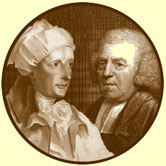| LACE HOME PAGE |
|
LOCAL LACE |
|
Harry Armstrong and the Bucks Cottage Workers' Agency |
||||||||
|
Taken from "Harry Armstrong and the Bucks Cottage Workers' Agency" by E. Knight (1989) Harry Armstrong was born in Stoke Goldington in 1886: his parents ran a grocery shop. By the turn of the century, many local women had given up lace making because there was no regular market. Armstrong saw that lace making could continue if there was a means of collecting and marketing lace made by home-based workers. To that end he set up, in 1906, the Buckinghamshire Cottage Workers' Agency in an outbuilding in the back garden of his family home. One of his marketing ploys was to exploit lace makers' plight shamelessly by appealing to the public's better nature in advertisements in various publications such as Needlecraft Monthly Magazine: another ploy was to trade as a woman! For example:
The following is a hand written letter circa 1920:
By 1909 Armstrong moved his premises to Midland Road, Olney in order to be near to better rail and postage services. The premises consisted of offices, warehouse and a sewing room where lace trimmed trousseaux were made. In 1911 he won a gold medal at the Festival of Empire & Imperial Exhibition at Crystal Palace. Between 1911 and 1914 Armstrong published a 144-page mail order catalogue, and adverts printed in 1916 state that the Agency gave regular employment to upwards of 600 cottage lace makers who worked in their own homes. In 1919, he published Thomas Wright's book "The Romance of the Lace Pillow". This is still in print and on sale in the Museum shop. The business flourished and in 1928 Armstrong had The Lace Factory built by George Knight in the High Street, Olney. The carving and lettering was by a Northamptonshire sculptor. A free standing carving over the door was removed for safety reasons and eventually ended up in the courtyard of the museum. This sculpture depicts a bobbin winder, flash stool, bobbin stand and fire pot. The Museum has a photograph, below, taken in 1918 of a group of lace-makers with those items (except the bobbin stand), all of which are on display in Museum, and illustrated on this site. The Agency continued throughout the 1920's and 1930's. Armstrong won numerous awards, including a gold medal at the Paris exhibition in 1925. He died unexpectedly in Scotland in 1943, following a short illness. He is buried in Stoke Goldington churchyard. The Lace Factory was used by Polaroid during the remaining war years and was then taken over as a lampshade factory in the 1950's. 1988 saw its conversion to flats & apartments but it still remains a striking feature of the High Street For more about Harry Armstrong and the Bucks Cottage Workers' Agency see the Stoke Goldington Village web site. |
|
|||||||

|
||||||||
| Images & text © 2009 The Cowper & Newton Museum (unless stated otherwise) | website by Jeremy Cooper at oliomedia |







